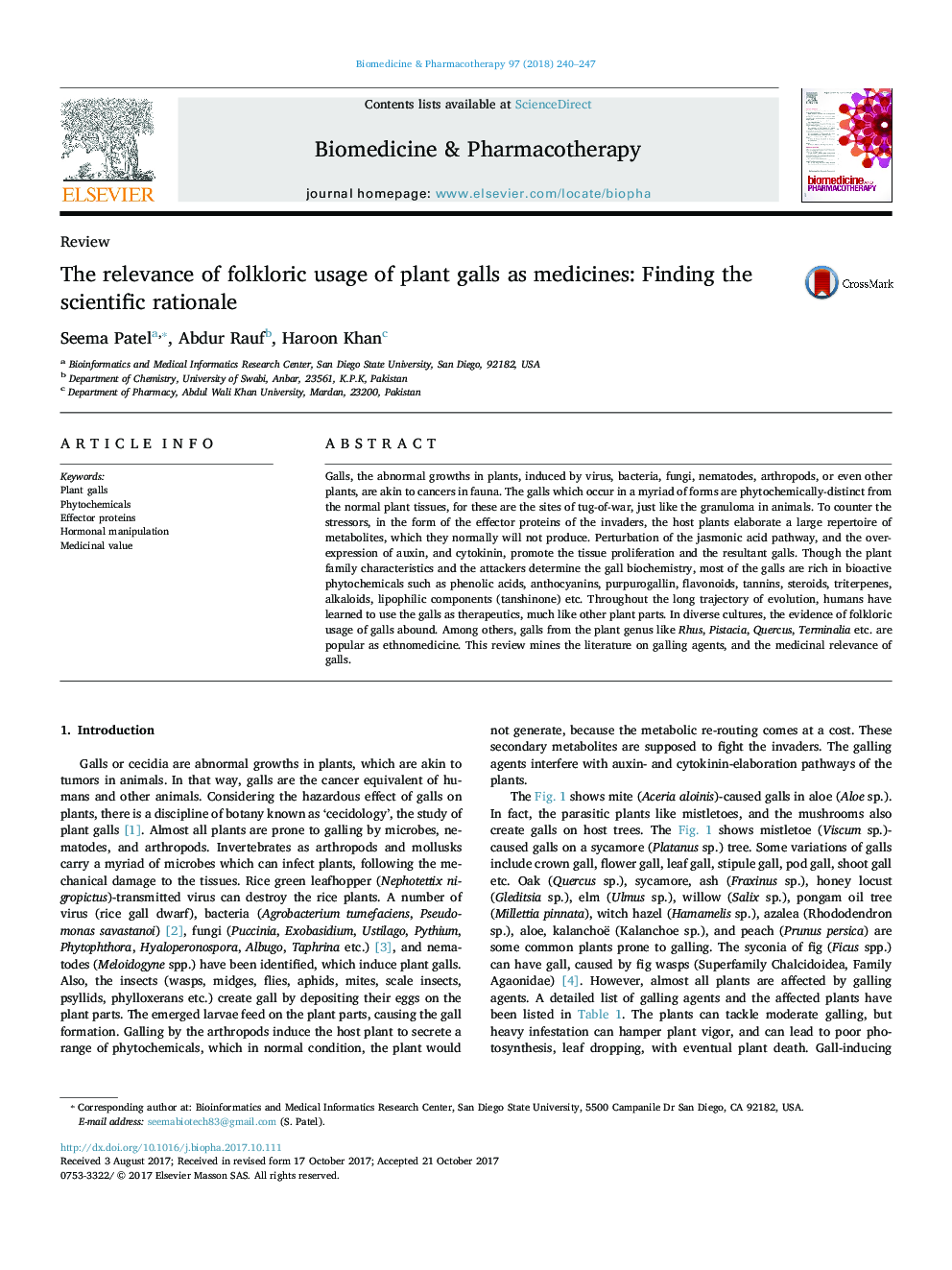| کد مقاله | کد نشریه | سال انتشار | مقاله انگلیسی | نسخه تمام متن |
|---|---|---|---|---|
| 8525954 | 1557945 | 2018 | 8 صفحه PDF | دانلود رایگان |
عنوان انگلیسی مقاله ISI
The relevance of folkloric usage of plant galls as medicines: Finding the scientific rationale
ترجمه فارسی عنوان
ارتباط اهمیت فولکلوریک گیاهان گیاهی به عنوان داروها: پیدا کردن علت علمی
دانلود مقاله + سفارش ترجمه
دانلود مقاله ISI انگلیسی
رایگان برای ایرانیان
کلمات کلیدی
ترجمه چکیده
گل، رشد غیر طبیعی در گیاهان، ناشی از ویروس، باکتری، قارچ، نماتدها، پرتقال یا حتی گیاهان دیگر، مشابه با سرطان های حیوان است. غلاتی که در شمار زیادی از اشکال رخ می دهند، از بافت های گیاهی طبیعی متمایز می شوند، زیرا اینها سایت هایی هستند که در حال کشیدن جنگ هستند، درست مانند گرانولوم در حیوانات. برای مقابله با استرسورها، به شکل پروتئین های مؤثر از مهاجمان، گیاهان میزبان یک پروتئین بزرگ متابولیت ها را تولید می کنند که به طور معمول تولید نمی کنند. اختلال در مسیر اسید جاسمونیک و بیش از حد بیان اکسین و سیتوکینین، ترویج تکثیر بافت و گلهای حاصل شده است. اگر چه خصوصیات گیاه خانواده و مهاجمان بیولوژیک ضایعات را تعیین می کنند، بیشتر غلظت ها در مواد شیمیایی زیست فعال مانند اسید فنولیک، آنتوسیانین ها، پورپوروگالین، فلاونوئیدها، تانن ها، استروئید ها، تریپرپن ها، آلکالوئید ها، ترکیبات لیپوفیلی (تانشینون) و غیره غنی هستند. انسان به این نتیجه رسیده است که گاه ها به عنوان درمان دار استفاده می شود، مانند سایر قسمت های گیاهی. در فرهنگ های گوناگون، شواهدی از کاربرد فولکلور از گلها وجود دارد. در میان دیگران، گلهایی از جنس گیاه مانند ریو، پسته، کوئرکس، ترمینال و غیره به عنوان علوم مردم شناخته شده است. این بررسی معادن ادبیات در مورد عوامل نابینا و رابطه دارویی از گل.
موضوعات مرتبط
علوم پزشکی و سلامت
پزشکی و دندانپزشکی
تومور شناسی
چکیده انگلیسی
Galls, the abnormal growths in plants, induced by virus, bacteria, fungi, nematodes, arthropods, or even other plants, are akin to cancers in fauna. The galls which occur in a myriad of forms are phytochemically-distinct from the normal plant tissues, for these are the sites of tug-of-war, just like the granuloma in animals. To counter the stressors, in the form of the effector proteins of the invaders, the host plants elaborate a large repertoire of metabolites, which they normally will not produce. Perturbation of the jasmonic acid pathway, and the overexpression of auxin, and cytokinin, promote the tissue proliferation and the resultant galls. Though the plant family characteristics and the attackers determine the gall biochemistry, most of the galls are rich in bioactive phytochemicals such as phenolic acids, anthocyanins, purpurogallin, flavonoids, tannins, steroids, triterpenes, alkaloids, lipophilic components (tanshinone) etc. Throughout the long trajectory of evolution, humans have learned to use the galls as therapeutics, much like other plant parts. In diverse cultures, the evidence of folkloric usage of galls abound. Among others, galls from the plant genus like Rhus, Pistacia, Quercus, Terminalia etc. are popular as ethnomedicine. This review mines the literature on galling agents, and the medicinal relevance of galls.
ناشر
Database: Elsevier - ScienceDirect (ساینس دایرکت)
Journal: Biomedicine & Pharmacotherapy - Volume 97, January 2018, Pages 240-247
Journal: Biomedicine & Pharmacotherapy - Volume 97, January 2018, Pages 240-247
نویسندگان
Seema Patel, Abdur Rauf, Haroon Khan,
